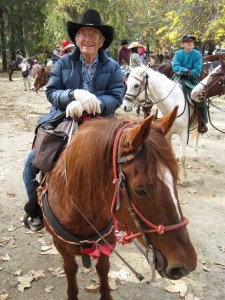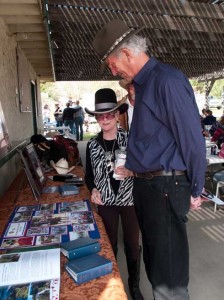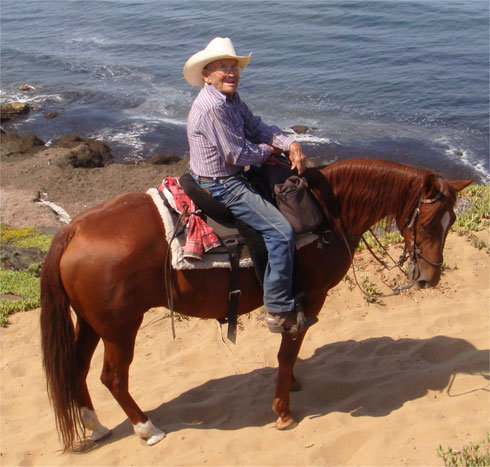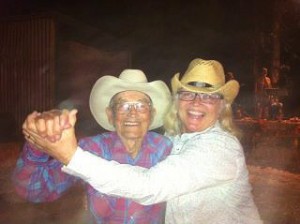Happy Trails, Bert Bonnett!
By Paula Parisi February 25, 2012
Bert Bonnett and Cassie on the ETI Corral 20 Christmas Trail Ride in 2010. (Photo courtesy ETI Corral 20)
He was only 5’3”, but Bert Bonnett cast a long shadow. The legendary Shadow Hills horseman was a fixture on the California trail riding scene, known for his ready smile and lively step, even as he approached his 102nd birthday Feb. 21.
He never made it, passing away peacefully on Jan. 23. That didn’t prevent 67 friends from celebrating Bonnett’s birthday as they had for dozens of years, with a group trail ride.
The Feb. 19 event culminated in a service attended by nearly 200 at Ranger Park in Lakeview Terrace. “We laid out his boots, spurs, saddle, bridle and hat, along with pictures of Bert and Cassie,” Bonnett’s wife Bari said, referring to the beloved mare he was forced to euthanize in 2011 following an accident in which the two were run off the road by a speeding driver.
Despite the setback, Bonnett got another horse and continued to trail ride, often as much as three times a week, up until a month before his death, Bari recalled. “People always asked Bert about the secret to his long life, and he said, ‘Good whiskey, pretty women and fast horses.’ I think of the three he might have loved horses the best. He was very comfortable in the saddle.”
Bonnett was born in Orem, UT, in 1910, and raised in a family of sheep farmers. Herding in the mountains, the family also caught, tamed and sold wild horses. Trail buddy and fellow Corral 20 member Janie Giauque remembered Bonnett telling her he was given his own horse to train at age 6.

Bari Bonnett and Max Schetter at the Feb. 19 memorial for Bert Bonnett. (Photo by Locus Ford / Microartisans)
Ten years after that he hitchhiked to California “with $1.50 in his pocket,” to meet up with his brother, who lived in Glendale. He worked as a plumber’s assistant and drove a three-mule wagon hauling dirt to build Union Station. He also served as a ranch hand for Cecil B. DeMille, teaching the racehorses to load. Prior to retirement at age 65 he was the welding foreman for National Frost Protection in Burbank. “Many of Bert’s neighbors and friends enjoyed the benefit of Bert’s welding skills,” longtime friend Susan Kaiser said.
In 1934 he and his first wife, Gladys, purchased the six-acre ranch in Shadow Hills where he lived until his death. In 1989 Gladys died of complications from a stroke. He met Bari on a group trail ride in Santa Barbara, and they were married in 1991. They wed on horseback, with “a flower mule,” at a ranch in La Tuna Canyon.
Asked what it was about the cowboy that caught her eye at that first meeting, Bari chirped, “He was the trail boss, and he was very good at it.” Horses, she said, are what drew them together and equines remained the center of their lives. Drawing on the skills he learned as a child, Bert was tapped to train many a mount, and he populated the local community with those he’d brought along.
“His whole attitude with horses was being firm but gentle with them,” Bari said. “He wanted the horses to know that people were kind, not something to be afraid of,” his wife remembered. He became known as a man who would make a gift of one of his well-trained trail horses and he was as generous with his time as his resources.
“There is one local woman, 72-years-old, he taught her how to ride when she was 11,” his wife recalled. “Another lady, now in her 40s, he gave her her horse when she was 16. There are people here who have known him for 65 years, which is not typical of California.”
The couple at one time had as many as seven equines―horses, a donkey and a mule they’d take on adventures that included nine Rose Bowl Parades (as part of the All American Donkey and Mule Society drill team), 23 Bishop Mule Days Celebrations and frequent jaunts in their 32-foot motor home, Bari at the wheel with a 20-foot horse trailer in tow.
“It was a three-horse trailer, but we had it reconfigured for two horses and two tack rooms. We had his-and-hers tack rooms. I was very fussy about my tack, and he would let his reins drag through the mud and stuff like that. We had very different ideas about that. I wouldn’t even give him a key to my tack room!”
Giauque explained how she met Bonnett in the early ’70s, through Equestrian Trails Inc., when he was a trail boss on what was then known as the Convention Ride, in the Lockwood Valley. The trip was to begin in a week and Giauque had a young Thoroughbred, unsuitable for the trip.
“Having the wrong horse and not ever having done this type of thing before sort of put my brakes on,” Giauque said. “We were at a Corral 20 meeting when everything was being discussed. I was so excited―I couldn’t believe that I had finally met people that had the same dreams. Bert took pity on me and said that I could go but I had to ride one of his horses, Poncho, and to bring clothes and a sleeping bag. The man had never even seen me ride! That ride started what was to be the best 40 years of my life,” she remembered, calling it, “just one example of Bert’s generosity, and why the world admired and loved him.”
ETI National president Linda Fullerton reminisced fondly as to Bonnett’s dedication to trail maintenance. “If you met Bert on the trail, he was always carrying his loppers and a pick ax. He scouted and led ETI National rides as well as rides for many different Corrals and Trail Blazers. You only had to ask and he would be willing to take the time to plan the perfect ride for your group.” How best to remember Bonnett? “He was known not only for his horseman skills, but for his smile. He was always happy.”
For more information about Equestrian Trails Inc., including a listing of local chapters, visit www.etinational.org.
Short URL: https://theequestriannews.com/?p=8567




